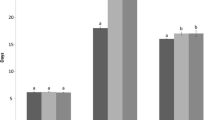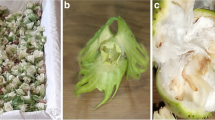Abstract
Chilo sacchariphagus Bojer is a serious sugarcane stalk borer in China. Screening of artificial diet formulations can provide the foundation for mass rearing indoor and biological research of C. sacchariphagus. Four different artificial diet formulations (I, II, III, IV) were set to feed for C. sacchariphagus. The experiment was carried out in a constant temperature incubator with temperature 26 ± 1 °C, humidity 75 ± 5 °C and photoperiod 14L:10D. The growth and development indexes were observed to determine the best feed formula for C. sacchariphagus. The results showed that the hatching rate, larval survival rate, pupation rate and fecundity of C. sacchariphagus fed with diet III (sugarcane stalk powder 40 g, sweet corn grain 240 g, yeast powder 20 g, agar 16 g, casein 10 g, sucrose 10 g, cholesterol 0.24 g, choline chloride 0.4 g, sorbic acid 1 g, methylparaben 1 g, multidimensional element sheet 1 g, 40% formaldehyde 0.5 ml and distilled water 800 ml) were higher than those of the other three formulas. From the life table parameters, the net reproductive rate (R0), the intrinsic rate of increase (rm) and the finite rate of increase (λ) of Formula III were higher than those of the other three formulas. In summary, artificial diet III is more suitable for the growth and development of C. sacchariphagus and can be used as a formula for indoor diet.


Similar content being viewed by others
References
Aran, B., and V. Ashok. 2016. Field population dynamics of Trichogramma chilonis on eggs of Sugarcane internode borer. Annals of Plant Protection Sciences 24 (1): 86–88.
Birch, L.C. 1948. The intrinsic rate of natural increase of an insect population. Journal of Animal Ecology 17 (1): 15–26.
Emre, I., and S. Yazgan. 1990. Effects of dietary components on reproduction of Pimpla turionellae L. (Hymenoptera:Ichneumonidae). Doga Turk Biyoloji Dergisi 14: 96–104.
Geetha, N. 2010. Management of internode borer Chilo sacchariphagus indicus (Kapur) by Trichogramma chilonis Ishii: appraisal of weekly releases at increased doses. Indian Journal of Entomology 72 (2): 155–169.
Geetha, N., E.D. Shekinah, and P. Rakkiyappan. 2009. Comparative impact of release frequency of Trichogramma chilonis Ishii against Chilo sacchariphagus indicus (Kapur) in sugarcane. Journal of Biological Control 23 (4): 343–351.
Guan, C.X., H.L. Xu, M.J. Lin, R.B. Liang, L.J. Chen, and J.H. Li. 2012. Prediction and forecasting of sugarcane stem borer and integrated control measures. Chinese Journal of Tropical Agriculture 32 (2): 42–46.
Huang, Y.K., W.F. Li, K. Shen, J. Yin, Z.M. Luo, X.Y. Wang, and H.L. Shan. 2014. Occurrence, damage and control strategies of sugarcane borers in Yunnan. Sugar Crops of China 2: 68–70.
Huang, C.H., X.K. Shang, J.L. Wei, and X.H. Pan. 2021. Investigation on the species of sugarcane borers in sugarcane planting areas of Guangxi. Plant Protection 47 (4): 186–189.
Huang, H.Q., J.R. Tian, Z.D. Xu, and B.G. **ao. 2001. Occurrence rule of Proceras venosatus in sugarcane. Sugarcane 8 (4): 20–23.
Jayakumar, J. 2017. Field evaluation of Sugarcane clones for resistance to borer complex. Annals of Plant Protection Sciences 25 (2): 263.
Li, J.L. 1983. The discovery, synthesis and application to technical appraisal meeting of sugarcane sex attractant of Chilo sacchariphagus were held in Panyu, Guangdong. Sugarcane and Canesugar 11: 36.
Li, G.H., Q.J. Chen, and Y. Pang. 1998. Studies of artificial diets for the beet armyworm Spodoptera exigua. Acta Scientiarum Naturalium Universitis Sunyatseni 37 (4): 1–5.
Li, J.X., G.N. Ma, Y.L. Yang, Z. Pei, H. Yuan, and X.B. Zhang. 2017. The influence of the artificial diet swith different dextrose levels on larval development and adult fecundity of the beet armyworm Spodoptera exigua (Hübner). Journal of Agricultural Catastrophology 7 (Z2): 38–39.
Li, W.F., J. Yin, Y.K. Huang, K. Shen, Z.M. Luo, X.Y. Wang, and H.L. Shan. 2014. The dynamics of population structure and control strategies of sugarcane borers in Yunnan. Journal of Agriculture 4 (8): 35–38.
Li, Y.R., and L.T. Yang. 2015. Sugarcane agriculture and sugar industry in China. Sugar Tech 17 (1): 1–8.
Lin, J.T., and X.Q. Liu. 1996. Study on semi- pure artificial feed of sugarcane Chilo sacchariphagus. Journal of Zhongkai College of Agricultural Technology 01: 50–57.
Ngomane, N.C., E. Pieterse, M.J. Woods, and D.E. Conlong. 2022. Formulation of artificial diets for mass-rearing Eldana saccharina Walker (Lepidoptera: Pyralidae) using the Carcass Milling Technique. InSects 13 (316): 2–19.
Nibouche, S., L.M. Raboin, J.Y. Hoarau, A. D’Hont, and L. Costet. 2012. Quantitative trait loci for sugarcane resistance to the spotted stem borer Chilo sacchariphagus. Molecular Breeding 29 (1): 129–135.
Nibouche, S., and R. Tibère. 2010. Mechanism of resistance to the spotted stalk borer, Chilo sacchariphagus, in the sugarcane cultivar R570. Entomologia Experimentalis Et Applicata 135 (3): 308–314.
Pan, X.H., J.L. Wei, X.K. Shang, C.H. Huang, A. Nikpay, and F.R. Goebel. 2020. The occurrence of Chilo sacchariphagus and its egg parasitoid wasps in sugarcane plantations in Guangxi China. International Sugar Journal 122 (1453): 58–63.
Paray, N.B., and S. Ganeshan. 2003. The entomopathogens as biological control agents against insect pests of sugarcane in Mauritius. Revue Agricole Et Sucriere De L’ile Maurice 82 (1/2): 67–71.
Pu, Z.L., D.A. Deng, Z.C. Liu, F.C. Hong, and Y.S. Mo. 1956. Study on reproduction and utilization of Trichogramma from sugarcane borer. Acta Entomologica Sinica 6 (01): 1–35.
Sallam, N., E.M. Achadian, L. Putra, T. Dianpratiwi, A. Kristini, D. Donald, and R.C. Magarey. 2016. In search of varietal resistance to sugarcane moth borers in Indonesia. International Sugar Journal 118 (1410): 450–452.
Sankaranarayanan, C., N. Somasekhar, B. Singaravelu, and M. Shanmugasundaram. 2008. Pathogenicity of entomopathogenic nematodes to sugarcane internode borer, Chilo sacchariphagus indicus Kapur (Lepidoptera: Crambidae). Journal of Biological Control 22 (1): 1–5.
Singh, P. 1977. Artificial deits for insects, mites, and spiders. New York, Washington, London: IFI/Plenum.
Singh, P., and R.F. Moore. 1985. Handbook of insect rearing. Amsterdam: Elsevier Science Publishers B. V.
Su, X.N., C.Y. Li, S.H. Huang, W.L. Liu, Y.P. Zhang, and Z.P. Pan. 2019. Optimization of artificial diet and rearing condition of fall armyworm, Spodoptera frugiperda (J. E Smith). Journal of Environmental Entomology 41 (5): 992–998.
Tan, Y.M., N. Zhuo, H.G. Li, R.L. Qin, H.C. Pan, and W.F. Zhang. 2011. Cane borers, their loss to cane yield and sugar content and their biocontrol. Journal of Cane Sugar 4: 18–25.
Wang, S.Z. 1993. Entomological research. China Agricultural Press 5: 160–161.
Wang, W.H., Y.Y. Yan, X.H. Liu, M.X. **, A.L. Yu, and G.A. **e. 2017. Effects of artificial diet on the growth and development of A. ferrugineus. China Forest Pests 36 (6): 26–28.
Wang, S.Y., Q.D. Zhu, Y.T. Tan, Q.L. Ma, R.F. Wang, M.F. Zhang, H.H. Xu, and Z.X. Zhang. 2019. Artificial diets and rearing technique of Spodoptera frugiperda (J.E. Smith) in laboratory. Journal of Environmental Entomology 41 (4): 742–747.
Wang, Y.N., Z.Q. Zhen, and Y.S. Zhou. 1984. Manual of insect artificial feed. Shanghai Science and Technology Press.
Wei, J.L., C.H. Huang, and B.H. Wang. 2013. Advances in artificial rearing of Lepidopteran insects. Sugarcane Industry 5: 44–47.
Wei, J.L., X.H. Pan, C.H. Huang, X.K. Shang, and S.H. Lin. 2019. Effects of temperature on the development and reproduction of spotted borer Chilo sacchariphagus (Lepidoptera: Pyralidae). Journal of Plant Protection 46 (6): 1277–1283.
Xu, H.L., M.J. Lin, J.H. Li, H.L. Gun, Y.X. An, L.J. Chen, W.X. Ou, and C.X. Guan. 2013. Predictive model of occurrence regularity of Proceras venosatum in sugarcane middle and later stage. Guangdong Agricultural Sciences 40 (12): 82–85.
Zeng, F.R. 2018. Research of insect artificial diet. Chinese Journal of Biological Control 34 (02): 184–197.
Zhang, X.X. 1997. Insect ecology and forecast, 2nd ed. Bei**g: China Agriculture Press.
Zhang, Y., D.Y. **u, X.D. Wang, H.T. Jiang, X.D. Zhang, and K.Y. Li. 2021. Influence of diet nutrients on insect biological and physiological characteristics. Journal of JiLin Forestry Science and Technology 50 (04): 39–43.
Zhang, Y.C., D.Y. Yi, C.Y. Lei, H.Y. **e, and X.Y. Li. 2008. Morphological characteristic and living habit of sugarcane borers and its control techniques. Guizhou Agricultural Sciences 36 (1): 95–96.
Zhou S.X. 2022. In spring, sow ‘sweet promise’-New Technology Press ‘Acceleration Key’ for Guangxi Sugarcane Industry. Guangming daily. 2.17, 3th.
Funding
This present study was supported by the Grants from Agriculture Research System of China (CARS-170305), Natural Science Foundation of Guangxi Province (2021GXNSFAA196002) and Guangxi Academy of Agriculture Sciences Foundation (2022JM12, 2021YT003, 2020YM26).
Author information
Authors and Affiliations
Corresponding author
Ethics declarations
Conflict of interest
The authors declare that they have no conflict of interest.
Additional information
Publisher's Note
Springer Nature remains neutral with regard to jurisdictional claims in published maps and institutional affiliations.
Rights and permissions
Springer Nature or its licensor (e.g. a society or other partner) holds exclusive rights to this article under a publishing agreement with the author(s) or other rightsholder(s); author self-archiving of the accepted manuscript version of this article is solely governed by the terms of such publishing agreement and applicable law.
About this article
Cite this article
Wei, Jl., Pan, Xh., Shang, Xk. et al. Screening of Artificial Diet Formulations for Sugarcane Stalk Borer Chilo sacchariphagus Bojer. Sugar Tech 25, 727–734 (2023). https://doi.org/10.1007/s12355-022-01232-1
Received:
Accepted:
Published:
Issue Date:
DOI: https://doi.org/10.1007/s12355-022-01232-1




